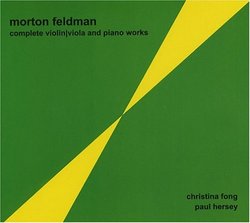Another fine, and even more thorough, survey of Feldman's st
Sparky P. | composer, all around nice guy, yada yada yada | 03/23/2006
(5 out of 5 stars)
"In this collection, Christina Fong and Paul Hersey perform not only the "official" (that is, published) works for violin and piano, but also add the only official work for viola and piano, and three unpublished works, the scores courtesy of the Paul Sacher Foundation in Switzerland. I will not dwell upon the official works (I previously talked about those in my review of the Sabat/Clarke collection on Mode), but rather on the other compositions. The violin sonata was written in 1945 when Feldman was 19 years old, and while it does not show yet his penchant for quiet surroundings, it does present Feldman at his most Bartókian, with fast octaves in the piano part and spiky harmonies between the two players. "The Viola in My Life 3" is the third in a four part series of works (five, if you include "Rothko Chapel", which was written at the same time) focusing the lovely and dark tones of the viola. This set was composed in 1971 and marked a new departure for Feldman. Previously were his compositions seen as quiet attackless works for ensembles with very subtle differences in timbre. Now he started writing more melodically (almost meoldy and accompaniment; "big Puccini-like melodies!"), but never losing feeling for his own kind of harmony. The first two VaIML for viola and small ensemble (almost the so-called "Pierrot Ensemble"), the fourth is for viola and orchestra (the first of 1970's "concerti"). VaIML3 is reduced to viola and piano and is a gorgeous miniature for the two instruments. Then there are the two very short works for solo violin. The four minute "For Aaron Copland" was written in 1981 and was intended for a short film about the elder composer. The piece has only single notes with rests in between, with the pitch material being the "white notes" of the scale (you really cannot say it is in C Major or A minor, but it has a pure modal sound nevertheless) and, compared to his works written until his 1987 death, no repeat marks were used. Whether it was a coincidence or a harbinger of things to come, it reminded me later of the modality that would be heard in the antepenultimate pages of "For Philip Guston". On the other hand, there is the untitled composition for solo violin that is quite dissonant and in which every measure bears repeat marks. This was supposedly written for Paul Zukovsky, with the idea of writing something for unadorned violin, but was most likely abandoned in favor of "Violin and String Quartet". Again the economy of Feldman comes through as there are only a specific number of material that is constantly reordered.
Overall the performances are very good and the recording quality is excellent. There is moment of pure coincidence when the violin's last note of "Projection 4" (written in graphic notation) happens to be its very first note of "Extensions 1" (written in standard notation). But this just confirms John Cage's assertion even more: Feldman's music does not change, but continue.
"


 Track Listings (10) - Disc #1
Track Listings (10) - Disc #1